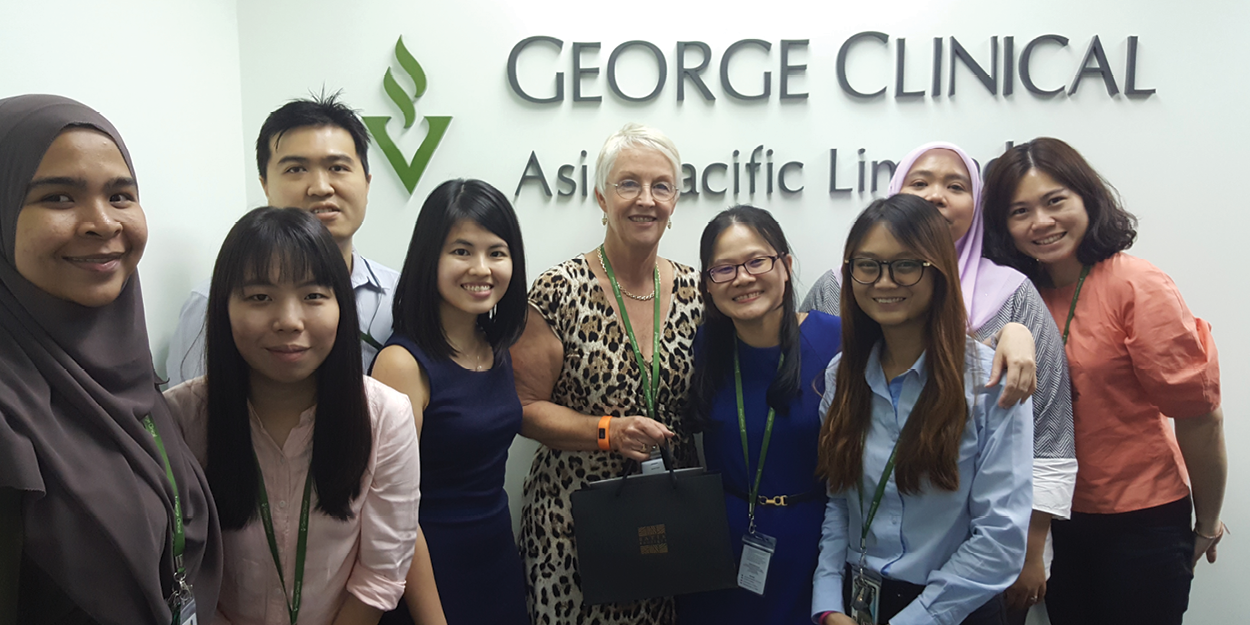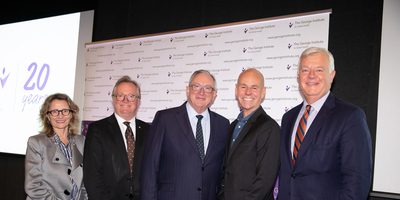
20 years of teamwork
George Clinical was formed in the early days of The George Institute, with a view to it playing a critical role in providing financial resources for the Institute to expand and strengthen its impact globally, as former CEO Dr Marisa Petersen explains.
Marisa first heard of The George Institute while head of the Australian Association of Regulatory & Clinical Scientists (ARCS). Having spent a number of years in contract research organisations (CROs) and pharmaceutical companies, she found herself accepting the role of CEO of George Clinical with a mandate to build an ‘internal CRO’ to deliver high-quality clinical trials for both commercial customers (at a profit), and for the Institute itself.
“I was missing the cut and thrust of actually delivering trials so it was exciting to have an opportunity to work with academic researchers focused on the scientific design of important clinical studies,” she recalls. “At the same time, I really appreciated being able to bring my expertise in commercial CRO operations and help deliver high quality trials for the Institute, as well as building the commercial side of the CRO.
“There's always been a little bit of a difference between the way academic and commercial studies are conducted. I saw an opportunity for the Institute to close that gap.”
One of the things that quickly became clear when she took on the CEO position was the distinctive synergistic relationship between The George Institute and George Clinical.
“When I joined in 2010, there were only about 60 people in George Clinical across China, India, Australia, and they were all employed by the Institute,” she says. “George Clinical had been operating for a couple of years, but really it was emerging from the Institute, and the people who identified as George Clinical were by and large people who were conducting academic trials within the Institute. We only had two commercial customers at the time!”
As a for-profit subsidiary, George Clinical’s key mandate was to provide additional funds and some sustainability for the Institute.
“At the same time, we were intertwined with the Institute because we could use the scientific expertise of the Institute to differentiate ourselves as a commercial CRO and thereby win more work from the pharmaceutical industry,” Marisa explains.
A niche was quickly identified for George Clinical to become a Pan-Asia CRO, aligning with where the Institute conducted most of its work, and drawing on its research expertise in Australia, India and China.
“While we were successful in delivering trials and giving surpluses back to the Institute, I was always most proud of the amazing contributions of the teams in all our locations because we weren't a big business that could put a whole lot of infrastructure in place,” Marisa says. “We were constantly demanding that they figure out how to deliver the studies, find the people to do the work, work remotely from head office in Australia etc., and those teams just constantly delivered.”
Marisa believes this team spirit and passion is born from the ‘profit for purpose’ role that George Clinical plays in the Institute’s mission.
“Our mandate was to always deliver back to the Institute and thereby support its mission, and a lot of our people really align themselves with that - they want to work for George Clinical because they believe in the Institute,” she says. “They can see the virtue – they believe in the mission and in providing strong evidence to drive change, particularly in developing countries.”
In terms of the role George Clinical plays in scaling up the research findings of the Institute, Marisa is clear this is where academic science and the commercial sector intersect. Indeed, this translation of the Institute’s research to scale up and greater impact is at the core of the synergistic relationship between the Institute and George Clinical.
“George Clinical's role has always been to help in the design of studies to meet clinical need, engaging with the commercial sector to secure funding and then delivering those studies such that any new treatments, new devices or new technical innovations are acceptable to regulators and can be commercialised effectively,” she says.
“We were always there as a facilitator, if you like, between the idea and the reality to actually produce the evidence,” says Marisa.
Marisa ended up staying in the role for over eight years before retiring at the end of 2018 after having grown George Clinical into a global organisation with 15 offices, more than 300 people, 300,000 patients globally and more than 500 completed studies.
Her greatest sense of achievement?
“I am delighted that George Clinical has been able to establish itself as a global scientifically backed CRO that is credible in the global marketplace, while also supporting the Institute,” she says.
“There was always a double bottom line – to provide money for the Institute to grow but also to provide high-quality data to support new treatment options. I am very proud of having helped develop the structure and processes that enabled us to do that.”
Marisa’s top moments
- Fulfilling a mandate: “Seeing George Clinical emerge as truly an entity in its own right, and fulfilling that mandate to be sound financially and provide surpluses, particularly in the early years, when it was critical for the Institute to have that money coming from George Clinical.”
- ‘Growth for purpose’: “By the time I left, we had offices across the globe and were providing a full range of services to support clinical trials. It was just fabulous to be part of that growth which supported the Institute and not just delivering on a financial bottom line, unlike many other CROs.”
- Part of a team: “With The George Institute, all parts of the organisation - the researchers, George Clinical, the newer social enterprises – are all working together to improve treatments and health care in both developing and developed parts of the world. That’s a really great thing to be a part of.”


